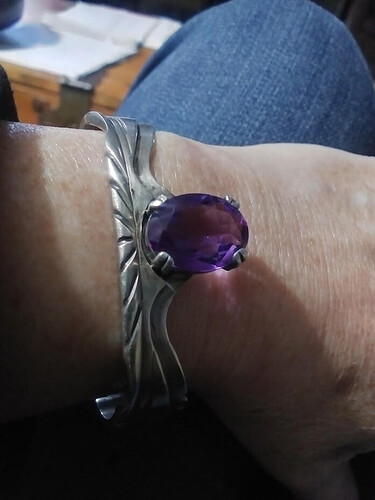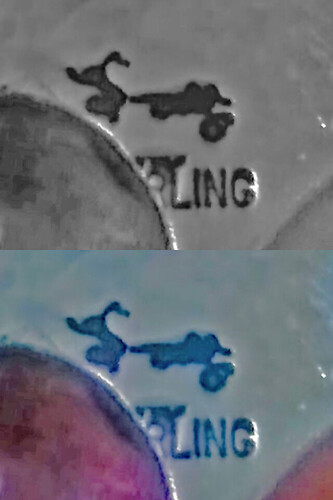My late husband purchased this for me and I was wondering who the maker was. Thank you for your help!
Pretty silver bracelet; I don’t recognize the hallmark. You didn’t specifically say that you believe this to be Native American, but in case you do (since you posted on a Native American forum), I don’t believe it to be Native American made.
Welcome to Turquoise People. I am so sorry for your loss. What does the hallmark say, or can you make out any letters?
Hi OrbitOrange! Thank you! I cannot make out anything and these are the only marks on it. We purchased it in a tiny town in AZ called Tortilla Flats about 20 years ago. They said it was Native American, which was all they sold at the time. I know it doesn’t have a strong native look. It does have the feathered silver bracelet.
Thank you Jason. I cannot make out anything and these are the only marks on it. We purchased it in a tiny town in AZ called Tortilla Flats about 20 years ago. They said it was Native American, which was all they sold at the time. I know it doesn’t have a strong native look. It does have the feathered silver bracelet.
Hi Steve, I know! It’s the only marking too beside the half Sterling one.
Hi OrbitOrange, I posted another pic of the side of the bracelet showing the feather design.
I did see the silver on the side, which does have a Native look to the design. I could be wrong. But what really strikes me as not typical for Native about it is the amethyst stone (not unheard of in NA jewelry but very very rare) and the pronged setting. Actually I’m wondering if this was cast—the main bracelet cast as one piece and the stone setting cast as another, and then soldered on. @mmrogers, care to weigh in?
And the way the stone shows through on the back also seems different.
What I can see looks hand fabricated. The stamped and filed border has a Navajo style radial line motif but I doubt it’s native made. Looks like there was originally a solid backplate, but the silversmith decided to cut out the oval behind the stone to let in more light later in the fabrication process.
I do see what you mean with regard to the setting looking like a casting. From the back there is no visible solder joint between the bezel and prongs. If hard solder was used it would be much closer to the color of sterling than easy solder, so wouldn’t necessarily be visible. That would also point to someone trained in classical silversmithing, rather than techniques typically used on the Rez.
I also thought it was not typical of a Native to use amethyst. It certainly could have been cast. I am so confused ![]()
@mmrogers yes, it was the fact that the stone setting looked to be all one piece with no soldering that made me wonder if it was cast, while the solder line between the setting and the main shank was quite visible. I don’t know and will defer to you; it was just a thought that I had.
No reason to be concerned. Casting and hand fabrication are both perfectly normal and desirable methods to make a piece of jewelry. Where the distinction comes into play with specific regard to Native American jewelry, is that the methods used, and maker are accurately represented to the customer.
Good observations, Orbit Orange! These are things most individuals don’t even think to look for, or even know about, because outside of our small corner of the word the end product is quite often all that matters.
And I wouldn’t even know how to look for some of those details ![]() That’s why it’s so fun to be on here and learn. But I have learned enough to know when to question things. Thanks both of you for sharing your knowledge.
That’s why it’s so fun to be on here and learn. But I have learned enough to know when to question things. Thanks both of you for sharing your knowledge.
@Silent01bigC , it’s possible the owners of the store didn’t know either, and just assumed. I can’t even begin to figure out what that hallmark is.
Is it possible that this lovely bracelet originally had a turquoise, or some other type of more traditional cabochon that was cracked or otherwise lost and another party added the amethyst stone, cutting open the back to allow for the fact that amethyst does well with more light? I’m certainly no expert, but would have seemed a loss to not use that gorgeous cuff.


